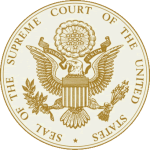- Industry: Government
- Number of terms: 836
- Number of blossaries: 0
- Company Profile:
The highest court in the United States. It's the judicial branch of the United States government. The U.S. Supreme Court has the ultimate appellate jurisdiction over all state and federal courts.
When the Court is deciding whether to grant certiorari in a case and thinks the view of the federal government might be relevant or useful — even though the United States is not a party — it can call for the view of the Solicitor General. The Solicitor General then files a brief in the case expressing the views of the United States government. Although a CVSG is technically an invitation, the Solicitor General always treats it as a command.
Industry:Government
Sometimes called the “tenth justice,” the Solicitor General is the lawyer for the U. S. Government, and attorneys in that office are responsible for presenting cases on behalf of the United States in the Supreme Court. Someone from the Solicitor General’s office will also frequently argue on behalf of the United States when the government is not a party but has filed an amicus brief in the case.
Industry:Government
When it decides a case, the Court generally issues an opinion, which is a substantive and often long piece of writing summarizing the facts and history of the case and addressing the legal issues raised in the case.
Industry:Government
The opinion issued by the court that heard the case immediately before the losing party asked the Supreme Court to review the case (almost always a federal court of appeals or a state court of last resort) is known as the opinion below.
Industry:Government
The United States is divided into thirteen circuits with a different court of appeals (see a map here). Eleven of the circuits are numbered first to eleventh. The District of Columbia has its own that hears many cases involving the federal government. The Federal Circuit’s jurisdiction is not geographic. Instead, it hears cases involving particular subject matters, such as patents and international trade. Courts of appeals are often referred to by the name or number of their circuit; for example, the “Ninth Circuit. ”
Industry:Government
“Friend of the court” brief; a brief filed by a person, group, or entity that is not a party to the case but nonetheless wishes to provide the court with its perspective on the issue before it. The person or entity is called an “amicus”; the plural is “amici. ”
Industry:Government
An order is an instruction or direction issued by the Court. Unlike an opinion, which analyzes the law, an order tells parties or lower courts what they are to do. For example, the Court can order certiorari granted or denied in a case; it can order a lower court to re-examine a case in light of a new point or theory; or it can order the parties in a case to conduct oral arguments on a certain date.
Industry:Government
The calendar of cases that the Court is scheduled to hear is known as the docket. A case is “docketed” when it is added to the docket, and it is given a “docket number” at that time. The Court’s docket shows all the official actions in that case, such as the filing of briefs and orders from the Court.
Industry:Government
The term “remand” means “to send back,” and refers to just that – a decision by the Supreme Court to send a case back to the lower court for further action. When it remands a case, the Court generally includes instructions for the lower court, either telling it to start an entirely new trial, or directing it, for example, to look at the dispute in the context of laws or theories it might not have considered the first time around.
Industry:Government
Once the Supreme Court has granted certiorari in a case, each party has the opportunity to file merits briefs. Unlike the certiorari-stage briefs, which tell the Court why it should or should not take the case, the merits briefs tell the Court why each party thinks he deserves to win.
Industry:Government
